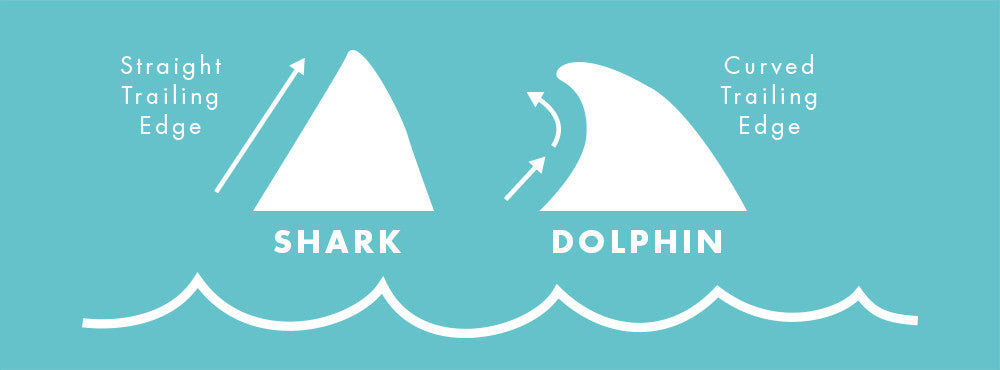Cart Details Should Go Here

SHARK SAFETY
Recently, there have been several great white shark sightings from Orange County all the way down to our local Seaside Reef, with one non-fatal attack at San Onofre. Luckily, shark attacks in San Diego are exceedingly rare. Even so, surfers and ocean-lovers alike are well aware that sharks are out there and should follow certain safety precautions to avoid potential run-ins with sharks. Here, we explain how to differentiate between a shark vs. a dolphin dorsal fin, safety tips to avoid shark encounters and some local species of harmless sharks.
“Ahhh, a fin!!” screams your friend pointing into the water. Don’t worry, it’s likely a dolphin. There are some major differences between dolphins and sharks, so learn what they are before inadvertently misidentifying your finned-friends.
Dolphin Fins
First off, dolphins, especially near shore, are much more common than sharks. Dolphins swim in groups and tend to drive the fish they eat close to shallow water. Dolphins breathe air and have to come to the surface, so you will see their fins much more often than sharks. The dorsal fins of dolphins are curved and their tails are horizontal, so you will rarely see their tails unless they are doing flips. Dolphins also move differently than sharks, as their tails pump up and down with their body, sometimes surfacing and slapping the water.
Shark Fins
Shark dorsal fins are straight and shark tails are vertically oriented so you may see the tip of the tail following the dorsal fin. Because of this orientation, sharks move in a more linear fashion through the water and the dorsal fins will remain on the surface in a more level manner as compared to dolphins. Sharks get their oxygen through their gills so they don’t need to come to the surface, which is why you can pretty much assume there are sharks around even though you don’t see them. You can blame Hollywood for the iconic-yet-unrealistic shark dorsal fin sightings, most sharks swim mid-water or close to the bottom floor.
Shark Safety Tips
- Avoid being in the water at dusk or at dawn, this is when sharks are hunting and may mistake humans for prey in lower lighting.
- Stay away from shark food such as sea lions, especially if they seem to be injured or acting erratic.
- Don’t swim alone and be aware of your surroundings. Stay away from large schools of baitfish, and be careful if spear-fisherman are present.
- Don’t struggle or splash a lot.
- Avoid wearing boardshorts or wetsuits which have high-contrasting colors and sparkly jewelry, which can resemble fish skin.
- Use beaches in busier areas and avoid swimming in remote areas.
Harmless Shark Species of San Diego
Leopard Shark (Triakis semifasciata) - You might see these speckled beauties in shallow waters such as La Jolla Shores. Leopard sharks swim on the ocean floor where they feed and although they can grow up to six feet, are completely harmless.

Soupfin Shark (Galeorhinus Galeus) - Soupfins, also known by other names like tope, flake, school shark and vitamin shark, swim in groups and are related to the leopard shark. Soupfins are identified by their pointed snout, slender bodies and very long tails. They love to swim around kelp beds like the ones in La Jolla Cove especially in August, grazing on fish and shellfish.

Photo Source: Monterey Bay Aquarium
Sevengill Sharks (Notorynchus cepedianus) - Late to early winter in La Jolla is when Sevengills come to visit. Named for their seven gills, these sharks have a broad snout and can grow up to 10 feet long, but prefer eating all sorts of sea life (and even other sharks!) rather than humans.

Ultimately, sharks don’t seek out humans for their food source (for example human blood is not a prey-related odor) and shark experts believe that sharks bite humans by accident. Humans are more deadly to sharks than vice versa, with humans killing approximately 100 million sharks per year. Worldwide, there are on average 82 unprovoked shark attacks annually. Those attacks aren't all fatalities, in fact between 2011-2015 there were eight fatalities a year worldwide and the U.S. had zero fatalities in 2016. Let's keep that trend going! By taking these steps to avoid looking like shark food and staying out of the water during hunting times, you are less likely to come face to face with the man in the grey suit.
Sources:
https://www.floridamuseum.ufl.edu/fish/isaf/worldwide-summary/
http://www.discovery.com/tv-shows/shark-week/lists/top-20-ways-to-avoid-shark-attack/
http://ktla.com/2017/05/10/15-sharks-spotted-off-san-onofre-beach-where-swimmer-was-injured-2-weeks-ago-warning-area-includes-orange-county/
http://edition.cnn.com/2015/08/17/opinions/mick-fanning-shark-surfboard-color/
https://www.floridamuseum.ufl.edu/fish/isaf/worldwide-summary/
http://www.arkive.org/leopard-shark/triakis-semifasciata/
https://www.montereybayaquarium.org/animal-guide/fishes/soupfin-shark
http://scubadivergirls.com/sevengill-shark-diving-la-jolla/
https://www.montereybayaquarium.org/animal-guide/fishes/broadnose-sevengill-shark